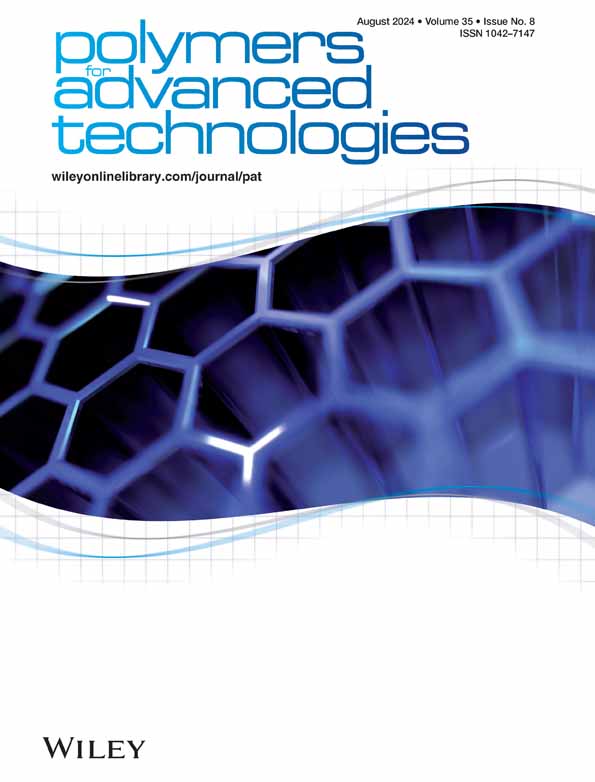Biocompatible nanocomposite for scaffolds in tissue engineering: A breakthrough discovery for regenerative therapy
IF 3.4
4区 工程技术
Q2 POLYMER SCIENCE
引用次数: 0
Abstract
By promoting tissue regeneration, porous nano‐scaffolds offer improved chances for the maintenance, repair, and enhancement of damaged tissues and organ functioning. In this study, the nanosilica extract obtained from the agricultural waste, that is, rice husk after surface modification shows higher hydrophobicity in the hexamethyldisilazane and methyltrimethoxysilane‐modified nanosilica and hydrophilic nature in 3‐aminopropyl triethoxysilane‐modified nanosilica. Fourier transform infrared spectroscopy results reveal the functional groups exist in the scaffold and its surface morphology was evaluated by Field emission scanning electron microscope/energy dispersive X‐ray analysis which shows a cross‐network structure that could impart the proper cell adhesion. The presence of amorphous nanosilica in ultrapure form was confirmed using X‐ray diffraction analysis where a broad peak was obtained in the range of 15°–40°. The crystallization phase of the hybrid scaffold shows 2θ values obtained at 22.6°, 28.7°, and 40.6°. The graph thus obtained confirms that the material used is 3‐aminopropyl‐triethoxysilane‐modified silk/silica nanocomposite. The decomposition rates and temperature of the composite were analyzed using the thermogravimetry/differential thermal technique. The antibacterial activity of the hybrid scaffolds and silk and silica shows the metabolic pathways were not disrupted for both Gram‐positive and ‐negative microbes. Cell cytotoxicity analysis proved that the electrospun hybrid scaffold was nontoxic to L929 cells and promoted cell adhesion and growth. The cells were highly proliferated onto the surface layers in a regular systematic pattern thus proving that these scaffolds were suitable for bone regeneration applications. Hence these economically viable scaffolds turn to be biocompatible and are promising as a novel product for cell culture regneration realted to therapy.用于组织工程支架的生物相容性纳米复合材料:再生疗法的突破性发现
通过促进组织再生,多孔纳米支架为维护、修复和增强受损组织和器官功能提供了更好的机会。在这项研究中,从农业废弃物(即稻壳)中提取的纳米二氧化硅经过表面改性后,在六甲基二硅氮烷和甲基三甲氧基硅烷改性的纳米二氧化硅中显示出较高的疏水性,而在 3-aminopropyl triethoxysilane 改性的纳米二氧化硅中显示出较高的亲水性。傅立叶变换红外光谱分析结果表明支架中存在官能团,场发射扫描电子显微镜/能量色散 X 射线分析评估了支架的表面形态,结果表明支架具有交叉网络结构,可赋予细胞适当的粘附性。X 射线衍射分析证实了超纯无定形纳米二氧化硅的存在,在 15°-40° 范围内出现了一个宽峰。混合支架的结晶相在 22.6°、28.7° 和 40.6°处显示出 2θ 值。由此得到的图表证实,所使用的材料是 3-aminopropyl-triethoxysilane 改性蚕丝/二氧化硅纳米复合材料。使用热重/差热技术分析了复合材料的分解率和温度。混合支架以及蚕丝和二氧化硅的抗菌活性表明,革兰氏阳性和阴性微生物的新陈代谢途径均未受到破坏。细胞毒性分析表明,电纺杂化支架对 L929 细胞无毒,并能促进细胞粘附和生长。细胞以有规律的系统模式在表层高度增殖,从而证明这些支架适合骨再生应用。因此,这些经济上可行的支架具有生物相容性,有望成为一种用于细胞培养和治疗的新型产品。
本文章由计算机程序翻译,如有差异,请以英文原文为准。
求助全文
约1分钟内获得全文
求助全文
来源期刊

Polymers for Advanced Technologies
工程技术-高分子科学
CiteScore
6.20
自引率
5.90%
发文量
337
审稿时长
2.1 months
期刊介绍:
Polymers for Advanced Technologies is published in response to recent significant changes in the patterns of materials research and development. Worldwide attention has been focused on the critical importance of materials in the creation of new devices and systems. It is now recognized that materials are often the limiting factor in bringing a new technical concept to fruition and that polymers are often the materials of choice in these demanding applications. A significant portion of the polymer research ongoing in the world is directly or indirectly related to the solution of complex, interdisciplinary problems whose successful resolution is necessary for achievement of broad system objectives.
Polymers for Advanced Technologies is focused to the interest of scientists and engineers from academia and industry who are participating in these new areas of polymer research and development. It is the intent of this journal to impact the polymer related advanced technologies to meet the challenge of the twenty-first century.
Polymers for Advanced Technologies aims at encouraging innovation, invention, imagination and creativity by providing a broad interdisciplinary platform for the presentation of new research and development concepts, theories and results which reflect the changing image and pace of modern polymer science and technology.
Polymers for Advanced Technologies aims at becoming the central organ of the new multi-disciplinary polymer oriented materials science of the highest scientific standards. It will publish original research papers on finished studies; communications limited to five typewritten pages plus three illustrations, containing experimental details; review articles of up to 40 pages; letters to the editor and book reviews. Review articles will normally be published by invitation. The Editor-in-Chief welcomes suggestions for reviews.
 求助内容:
求助内容: 应助结果提醒方式:
应助结果提醒方式:


